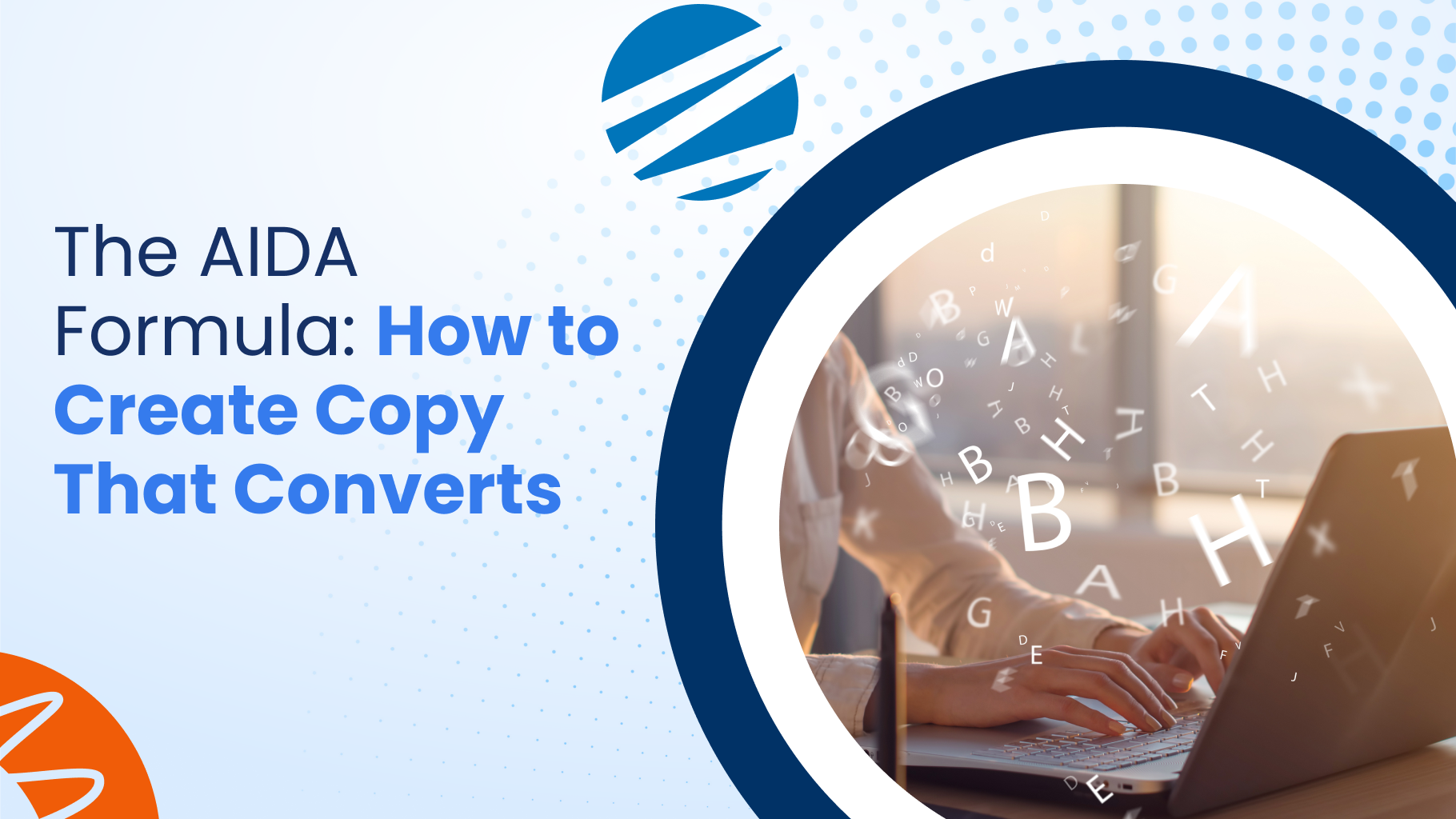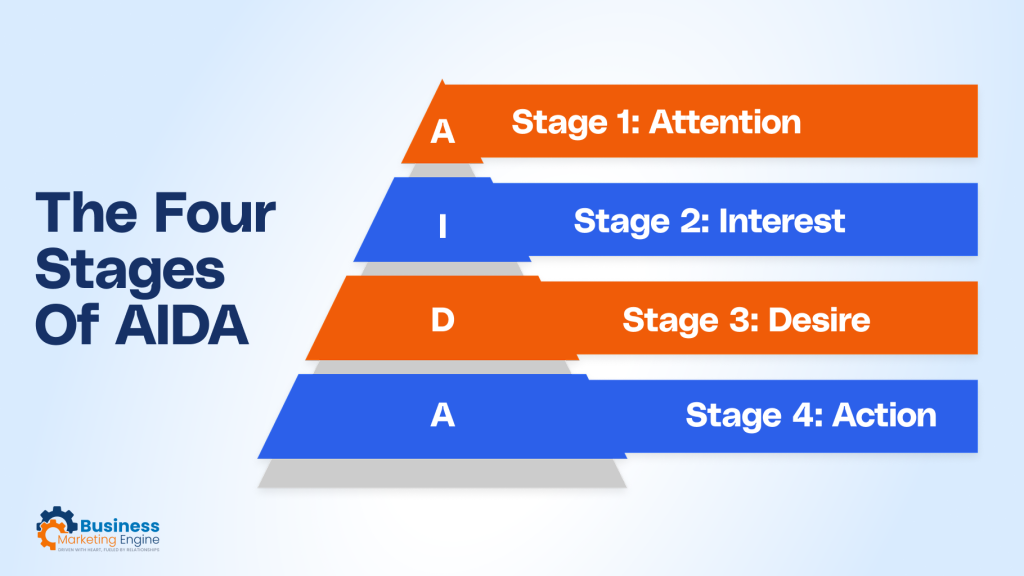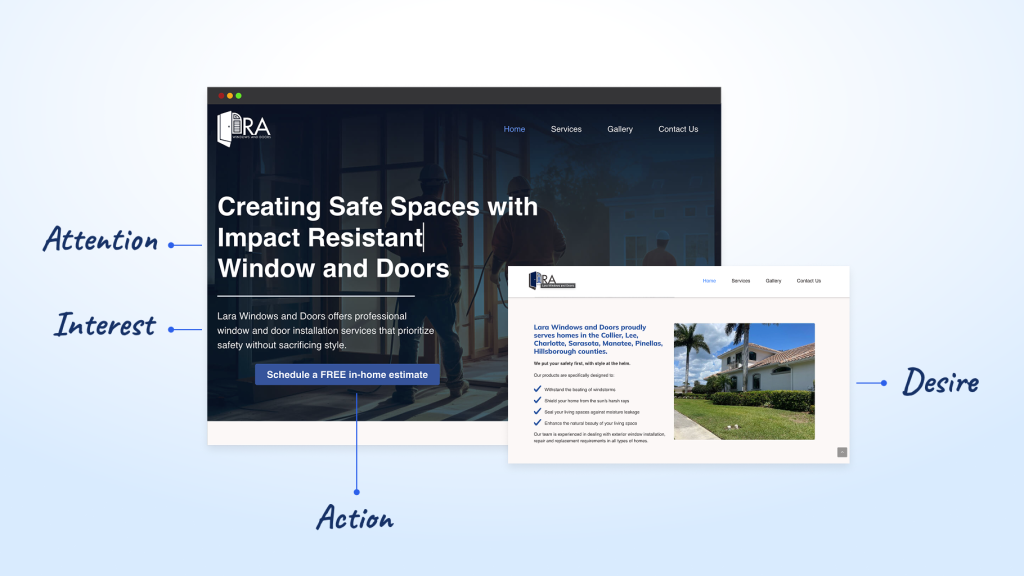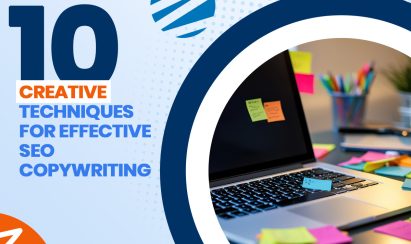You’ve got just a few seconds to grab someone’s attention online.
How do you do it? With the AIDA formula. This is a proven method that helps you turn curious viewers into loyal customers.
The AIDA formula stands for Attention, Interest, Desire, and Action. And it’s the secret behind some of the most successful marketing campaigns!
Ready to boost your conversions and create content that actually works? Let’s dive into the AIDA formula!
The Four Stages of AIDA
The AIDA formula is a four-step process. Each stage helps you learn how to guide your audience through the marketing journey.
Stage 1: Attention
Let’s start with the basics.
Grabbing Attention in a Crowded Market
There is so much competition for online attention. We’re constantly bombarded with information in every direction.
From social media notifications to pop-up ads, it’s no wonder staying focused is so hard!
Attention is fleeting; you have about 8 seconds to grab someone’s focus before they start to think about something else.
So, how do you catch people’s attention and hold onto it? It all comes down to how you present your message. From headlines to visuals and compelling opening lines, these components need to work together like a well-oiled machine.
Techniques to Capture Attention
Now that you know how quickly attention can slip away, let’s talk about how to grab it and keep it.
A powerful hook can be the difference between someone sticking around or leaving your page. Start with something bold or unexpected that makes them want to read more.
Then, tap into your audience’s pain points. Whether it’s frustration, fear, or desire, when you address a problem they’re already thinking about, they’ll keep reading.
Nothing gets a person’s attention faster than a surprising statistic. Questions also work wonders. Ask something that makes your reader stop and think.
And don’t underestimate the power of bold statements – something confident and direct.
Attention isn’t just based on words. Design and formatting play a role in keeping people engaged too. Use clean, easy-to-read layouts with bold headings and eye-catching visuals to draw your audience in.
Stage 2: Interest
It’s time to show your audience that what you have to offer is worth sticking around for.
Building Interest Once You Have Their Attention
Your audience is hooked; now it’s time to dive deeper to keep them engaged.
Make your copy relevant to the audience’s needs or problems. Start by addressing their concerns and show them that you get where they’re coming from.
Is there a pain point that you touched on in your headline? Keep that momentum going by offering valuable insights, solutions, or tips that show you understand their situation.
Make sure there’s a smooth transition from your initial statement to showcasing your content.
A smooth transition might be as simple as asking a question that leads into the next section of your content. Or offering a little preview of what’s coming up next. Whatever it is, it should feel natural.
Techniques to Spark Interest
How can you spark your audience’s interest?
Through storytelling. This is effective because people connect with stories on a personal level. It helps humanize your message and make it relatable.
Emotional engagement takes it further by tapping into your audience’s deepest hopes, fears, or aspirations. This creates a bond that goes beyond a product or service.
Finally, showcasing your unique value propositions (UVPs) helps you stand out from the competition. UVPs help you explain what makes your offer different from those of your competitors.
Stage 3: Desire
It’s time to turn that curiosity into desire.
Turning Interest into Desire
This is where you shift from simply keeping your audience intrigued to making them think, “I want this!”
The key here is to showcase benefits instead of just listing features. While features describe what your product does, benefits explain how it will improve your audience’s life.
Strategies to Create Desire
You need to paint a picture of what life could look like after using your product or service.
Highlighting transformation through before-and-after scenarios shows potential customers the change they can expect. This could be solving a problem, achieving a goal, or experiencing a major shift in their life.
People trust other people’s words more than a company’s. That’s why leveraging social proof like testimonials, reviews, and case studies from real customers proves your brand to be trustworthy.
Don’t forget to create urgency to drive immediate action. Tactics like limited-time offers or emphasizing scarcity encourage potential customers to act now rather than later.
Stage 4: Action
Once you’ve sparked desire, it’s time to push your audience from passive interest into taking action.
The Importance of a Clear Call-to-Action (CTA)
This is where a clear call to action comes in. A strong CTA doesn’t just tell your audience what to do next – it guides their behavior and drives conversions.
Your CTA needs to be very clear so your audience knows exactly what they will be getting.
To really motivate clicks, you need to use action-oriented language that creates a sense of urgency or excitement.
Words like “Buy Now,” “Get Started Today,” or “Claim Your Spot” push people to take immediate action.
Crafting Effective CTAs
A great CTA is more than just a button.
To craft CTAs that really work, you need to think about placement, design, and clarity. Let’s break each one down:
Placement: You want your CTA to be easily noticeable but not intrusive. It should stand out enough to grab their attention but feel natural within the flow of the page.
Design: Use contrasting colors to make it pop, but make sure it fits with your overall branding. It should look clickable. Use buttons and clear borders to encourage action.
Clarity: Your CTA needs to tell your audience what to do next. It’s not enough just to say “Click Here” or “Submit”. Be specific and action-oriented, like “Get Your Free Ebook” or “Start Your Free Trial.” Make it clear what they’ll get and why they should click.
Some examples of high-converting CTAs:
Sign Up for Free (creates value and urgency)
Get Started Now (encourages immediate action)
Shop the Sale (urgency around a limited-time offer)
Learn More (for content that requires further explanation)
No CTA is perfect from the get-go. To maximize performance, you need to test and optimize them regularly.
Start A/B testing different CTAs to help you see what works best for your audience. This can show you where you need to make small tweaks to get better results.
How to Apply AIDA Across Different Formats
AIDA in Website Copy
Structuring website pages using AIDA principles will help you create a seamless flow that guides visitors toward taking action.
Here’s how the AIDA formula works across different parts of your website:
Attention: Your homepage is the first impression visitors have of your business. It needs to grab their attention right away! A bold, engaging headline, paired with captivating visuals or a video, can quickly pull people in.
Interest: Once you’ve grabbed their attention, keep them hooked by addressing their pain points or needs. Use your product pages or service pages to highlight how your offerings solve specific problems.
Desire: This is where you turn interest into a deeper craving. On your landing page or product page, show your visitors how your product or service will make their lives better. Use before and after scenarios, customer testimonials, or features and benefits to create a strong emotional connection.
Action: Make sure there’s a strong and clear CTA. Whether it’s “Buy Now”, or “Get Started”, the CTA should be visible and easy to find. Make it action-oriented and urgent!
AIDA in Email Marketing
To make sure your emails stand out in a crowded inbox, you need to apply the AIDA formula strategy.
Attention: It all starts with your subject line. This is your first and often only chance to capture the reader’s attention. A great subject line should spark curiosity, urgency, or speak directly to a pain point your audience is feeling. It needs to be concise, intriguing, and create a sense of “I need to open this right now!”.
Ex. “Are You Making These Marketing Mistakes?”
Interest: Once your email is opened, it’s time to build interest. Start by addressing the reader’s pain points or needs. Your body copy should offer something valuable. Whether it’s insights, tips, or solutions, keep it relevant to what they’re looking for and make it personal.
Ex. “This tool will save you hours of work each week!”
Desire: Show your readers why they should want what you’re offering and what it will do for them. Highlight benefits, use emotional appeal, or introduce limited-time offers to push the reader from “that’s interesting” to “I want it now!” You can include social proof to reinforce the value.
Ex. “See how these companies increased their revenue by 30% with this tool”
Action: You need a clear and actionable CTA that prompts readers to take the next step. The CTA should be easy to spot and include a sense of urgency.
Ex. “Offer Ends in 24 Hours!”
AIDA in Social Media Content
Social media is all about quick, engaging content that stops people from scrolling. Applying the AIDA formula to platforms like Instagram, Facebook, and LinkedIn will help grab attention, build interest, and spark desire.
Attention: You don’t have much time to grab attention on social media platforms. The first few words of your post or the image in your feed are what will either stop someone from scrolling or let them move past. To get their attention, use eye-catching visuals that stand out.
Interest: Offer something valuable to keep followers interested. For Instagram, this could be a quick tip or a fun fact. On Facebook, this could be an insight or a question that gets your audience thinking.
Desire: To show how your brand can offer value to your audience, help your followers feel like they are a part of something. Use real-life stories and share user-generated content so your followers feel represented in the community.
Action: Your social media posts should also include strong CTAs. This could be a link in your stories, posts, or bio.
AIDA in Video Scripts
Videos are one of the most engaging forms of content.
But with people’s attention spans now shorter than ever, you need to capture their attention within the first 5 seconds.
The key to keep people hooked is to make your video both relatable and valuable.
Finally, end your video with a strong CTA to drive conversions.
Advanced Techniques to Enhance AIDA
To enhance AIDA, integrate it with other frameworks to create a deeper emotional connection to your audience.
Combining AIDA with Other Frameworks
When you combine the AIDA formula with other frameworks, you create messages that become more compelling.
One great example is integrating AIDA with PAS (Problem-Agitate-Solution).
PAS digs deeper into your audience’s emotional triggers by first identifying their problem, intensifying the discomfort around it, and then offering your solution.
When paired with AIDA, PAS helps make the Attention phase more impactful by immediately addressing a pressing issue. It makes the Desire phase even stronger by showing how your solution directly alleviates that pain.
Another useful combination is using the AIDA formula alongside storytelling frameworks.
Stories are naturally engaging, and when you craft narratives that follow AIDA’s structure, you create content that keeps your audience interested and emotionally invested.
For example, telling a story of how your product helped someone overcome a challenge can build interest and desire. Then, ending your story with a strong call to action can lead to conversions.
Personalization in AIDA
Use customer data and analytics to tailor your messaging at each stage. Aim for these to directly address your customers’ needs, desires, and pain points.
For example, if you’re targeting small business owners, your Attention phase might highlight challenges like time management. The Desire phase could showcase how your product streamlines its processes.
Analytics also play a huge role here. Data-driven insights let you optimize your copy for better results, ensuring that each part of the AIDA formula hits the right emotional note.
Visual Elements to Complement AIDA
Images, infographics, and videos help grab attention quickly. Clarify your message in the Interest phase, and make the transformation more tangible during Desire.
That way, you can guide your audience to action in the Action phase.
For example, showing a short demo video or testimonial on a landing page makes the Desire stage more compelling because you’re offering proof that your solution works.
The design of your content also plays a role in readability and engagement.
Clear typography, strategically placed CTAs, and consistent branding elements help guide your audience’s eyes. This makes it easier for them to follow your message and ultimately take action!
Common Mistakes to Avoid When Using AIDA
Let’s avoid these mistakes when implementing the AIDA formula.
Overloading Attention
In an effort to grab attention, it’s easy to go overboard with flashy elements—bright colors, bold fonts, and loud imagery.
But too many of these can actually have the opposite effect, overwhelming the viewer and causing them to tune out.
Creativity is important, but clarity should always come first.
Instead of bombarding your audience with a visual overload, aim for a balance. Use attention-grabbing elements that align with your message. And make sure to guide the viewer’s focus.
Simplicity, in many cases, is the ultimate form of creativity.
Losing Focus on the Audience
One of the biggest mistakes when using AIDA is making the copy about you, rather than your audience.
It’s easy to fall into the trap of talking about your product’s features or your company’s achievements. But the audience is looking for something that they can relate to.
Every stage of AIDA needs to be centered on the audience’s needs, pain points, or desires.
You need to continually ask yourself, “How does this benefit them?” If your message focuses too much on the brand and not enough on the audience’s problems or aspirations, you risk losing relevance and, ultimately, their attention.
Weak or Missing CTAs
A weak or missing call-to-action (CTA) can completely undermine your entire AIDA structure.
If the action you want your audience to take is unclear or buried under too much fluff, conversions will suffer.
A strong CTA is direct, action-oriented, and leaves no room for ambiguity.
A vague CTA like “Click Here” doesn’t give users a clear sense of urgency or direction. Instead, try something like “Get Started Today” or “Claim Your Free Trial.”
A missing CTA can be just as damaging. If your audience doesn’t know what the next step is, they’re unlikely to take it. When in doubt, always guide the audience with a clear direction and test different CTAs to see what performs best.
Tips for Testing and Optimizing Your AIDA-Based Copy
To truly understand how well your AIDA-based copy is performing, you need to track key metrics.
Measuring Success
Key metrics to track include:
Click-through rate (CTR): Tells you how many people clicked on your content after seeing it—this is a great indicator of how well your Attention phase is working.
Bounce rate: Measures how many visitors leave your site after viewing just one page, which can show if your copy is losing their interest too soon.
Conversion rate: The ultimate metric – it shows how many people took the desired action, whether it’s signing up, purchasing, or subscribing.
To measure your copy’s effectiveness, use tools like Google Analytics, Hotjar, and HubSpot.
These tools allow you to track metrics and gain actionable insights. They can help pinpoint where you’re losing people and which stages of AIDA need more attention.
Split Testing Your AIDA Copy
One of the best ways to optimize your AIDA copy is through A/B testing (or split testing).
This involves testing different variations of your copy to see what resonates most with your audience.
Start by testing individual elements—like your headlines, CTAs, or even the order of information in your content.
For example, you could run two versions of a landing page. One could have a headline that’s benefits-focused, such as “Get Your Dream Body in Just 3 Weeks”. Another could have a headline that highlights a challenge, like “Struggling to Stay Fit? This Will Help”. Track which version leads to more clicks and conversions, then refine based on the results.
Analyzing these results will give you data on which copy elements are working and where you can improve. The goal is continuous improvement.
After each test, implement what you’ve learned to make your future campaigns even more effective.
Conclusion
The AIDA formula continues to be a cornerstone for effective copywriting because it taps into fundamental human psychology.
Its straightforward, step-by-step approach makes it powerful for creating copy that connects with audiences and drives conversions.
By embracing AIDA, you can create more compelling and persuasive content that speaks directly to your audience.
If you’re not already using the AIDA formula in your copywriting, it’s time to start. Apply the formula, get creative with your approach, and watch your conversions soar! Our expert marketing team is here to help you through every step of the way. Book a call with us today!






